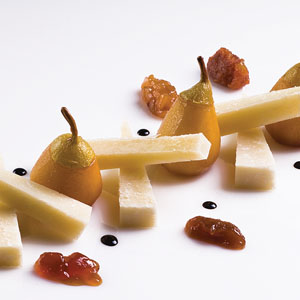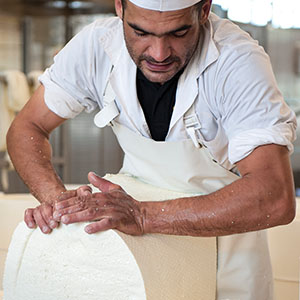Pecorino starts with the sheep. It’s even in the name — Pecorino cheese is named after pecora, the word for sheep in Italian. The three Pecorini begin with pure, fresh, whole sheep’s milk from the idyllic island of Sardinia.

Pecorino is one of the world’s most ancient cheeses. The three Pecorini trace their roots back to Sardinia’s ancient history of traditional shepherding and cheesemaking, although the oldest Pecorino most likely comes from even before that, in the countryside near Rome.
Ancient Roman scholars, including Varro, Galen, Virgil and Pliny the Elder, made historical references to cheese production techniques not much different from today’s Pecorino. Pecorino could be found on the tables of Republican senators and consuls, where it was often enjoyed during special occasions and prized for its wonderful, complex flavor. It was also a practical food that sustained many — its high quality nutritional value and long shelf life made it a perfect staple for the famous Roman legionnaires to take on their expeditions.
In his book “Cheese and Culture”, Paul S. Kindstedt writes, “cheese making was an important part of the Roman military machine, and in times of peace legionnaires even may has doubled as cheesemakers themselves.” Roman soldiers were allotted 1 ounce of Pecorino as part of their daily rations.
Kindstedt explains that in ancient times, Pecorino served as a good candidate for export: “rugged and able to withstand the rigors of maritime transport, bursting with robust piquant flavor, versatile for use at the table as opson or for grating and as an ingredient in cooking.” Pecorino was then, as it is today, a cheese of many uses and assets.

Sardinia
Sardinia is the second largest island in the Mediterranean Sea, after Sicily. It has more than a thousand miles of coastline, sandy beaches and rugged, stunning landscapes dotted with thousands of nuraghi, Bronze Age stone ruins. The rocky, dry land makes it a difficult place for farming, but an ideal environment for raising sheep. Sheep farming in Sardinia has ancient origins that date back to the Nuragic Civilization, before the first millennium BCE.
Shepherding is at the heart of Sardinian culture. In prehistoric times, the Nuragic people produced sheep’s cheese — it was the perfect way to preserve their plentiful milk. Milk would spoil quickly, but Pecorino could last for months, and even years, and maintain its excellent taste and nutritional value.
Sheep farming and cheese production continue to thrive. They play a significant part of the island’s economy today: there are around three million sheep on the island, 1,800 farms and 60 cheesemaking facilities. Sardinia produces more than 68 percent of Italy’s total sheep milk supply.
An indigenous sheep breed called Sarda provides the fresh milk that gets transformed into Pecorino. Sarda sheep are unique to Sardinia and have ancient origins — they are descendants of the wild mouflon of Gennargentu. The Sardinian sheep have perfectly adapted to the mountainous, rough terrain of the island, where they roam in wild, wide pastures today. Sheep’s milk is significantly higher in fat and protein that cow or goat’s milk. The high fat content of sheep’s milk gives its cheese a buttery, rich dimension. It also tends to be nutty, sometimes with a hint of gaminess.
Today, Sardinian sheepherders guide their sheep along the green valleys and steep mountains of their island the same way their ancestors did — in utmost harmony with the land, the environment and their tradition.

Seal of Authenticity
In 1996, the European Union certified three Sardinian sheep’s milk cheeses with the Protected Designation of Origin (PDO) — Pecorino Romano PDO, Pecorino Sardo PDO and Fiore Sardo PDO All three are Sardinian culinary treasures that capture the ancient farming and cheesemaking traditions of the region. The Protected Designation of Origin label certifies the highest quality guaranteed by their territory of origin. These beloved Sardinian cheeses are the result of unspoiled land, ancient and treasured tradition, happy, healthy sheep, and a dedicated team of cheesemakers.
How can you tell if a Pecorino PDO cheese is the real deal? The wheels are branded with labels on their rinds designed by each Consortium to distinguish them from imitations. To ensure you are choosing a certified Sardinian PDO sheep’s milk cheese, always look for the European PDO red and yellow logo and the specific logo of the Consortium.
Pecorino Sardo PDO
Pecorino Sardo PDO is known as one of the oldest cheeses of Sardinia and is produced following a careful process that has been adhered to for countless generations. Pecorino Sardo PDO is made in two different varieties: Dolce (mild) and Maturo (mature), which differ in production technique, size, aging and flavor.
Pecorino Sardo Dolce is shaped like a cylinder, with a pale yellow rind. This cheese has a soft, springy texture and each wheel weighs about 5 pounds. Sardo Maturo has a darker, smoother surface, a firmer, compact texture, and is usually about twice the size. The Dolce is aromatic, while the Maturo has a more spicy and robust flavor. Both cheeses are excellent on a cheese platter with crusty bread or grated over pasta or rice. They pair beautifully with Montepulciano or a hoppy IPA.

Pecorino Romano PDO
The production of Pecorino Romano boasts ancient origins throughout the countryside surrounding Rome. Although the region around Rome is the birthplace of Pecorino Romano, Sardinia has been the main production hub for the cheese since the end of 19th century, when Roman legislators imposed a ban on cheesemakers salting cheeses inside their shops. Pecorino Romano production was moved across the Tyrrhenian Sea to the shores of Sardinia, where it remains today, protected by the PDO seal.
Pecorino Romano PDO is a firm, flaky cheese made with fresh full-fat sheep’s milk from the Sarda sheep breed. Sheep roam in the pastures of Lazio, Sardegna and the province of Grosseto, and their milk is transformed into this classic cheese. Its thin rind is a straw-yellow color, and beneath the exterior, the cheese is aromatic, intensely sharp and salty. The wheels are massive—between 35 and 55 pounds. Each wheel is branded with the mark of origin (the seal with a stylized sheep’s head, of course), the initials of the cheese maker, and the date of production. Pecorino Romano PDO must mature for at least five months for the table cheese category and eight months to be sold as a grating cheese. It’s made the same way as it has been for centuries.
Because the cheese’s moisture content is so low, it’s not easy to melt. It’s perfect for grating over pasta or munching with crusty bread, fresh vegetables and fruit, and a juicy red wine, like Cabernet Sauvignon or Chianti.
Fiore Sardo PDO
Fiore Sardo PDO has always been considered the quintessential cheese of Sardinian sheep farmers, and, for centuries it was Sardinia’s biggest product. It has been crafted by sheepherders for millennia, since the Bronze Age. Shepherds lived in mountain huts, which were built around a central fireplace. They made wheels of sheep’s milk cheese, then left them to rest as they matured on a bed of reeds close to the fire, which gave Fiore Sardo its signature smoky aroma.
The name Fiore Sardo is said to derive from the fact that, in ancient times, the flower of the cardoon was used as natural rennet in the cheesemaking process. Others claim the name comes from the use of wooden stamps molded with an engraved flower that, until recent times, served to distinguish and decorate the cheese.
The cheese has a firm but pliable texture, with smoky notes and a piquant, nutty flavor. The subtle smoke is a great compliment to the sheep’s milk’s richness. It’s fruitier and less salty than Pecorino Romano and aged for about six months. Savor Fiore Sardo’s unique flavor pairs perfectly with a red wine, such like Cannonau di Sardegna DOC.

Pecorino Sardo Maturo, Ricotta & Broccoli Quiche
Preparation time 25 minutes, Cooking time 35-36 minutes, 9-inch diameter pan
Serves 6
Ingredients:
1 package shortcrust pastry filling:
7 oz Ricotta
4 oz Pecorino Sardo Maturo PDO
10.5 oz of blanched broccoli florets
4 eggs
3 oz milk
salt, pepper
In a bowl, mix eggs, salt, pepper, milk and ricotta. Beat until well-blended
Add the grated Pecorino Sardo Maturo cheese and broccoli florets.
Roll out the shortcrust pastry and line the greased and floured pan.
Add filling, smooth, roll up dough at edge.
Bake at 350°F for 30 minutes, then cook in a convection oven with heat from below only for 5-6 more minutes.



